Geography - Tribal Distribution in world | 12th Geography : Chapter 5 : Cultural and Political Geography
Chapter: 12th Geography : Chapter 5 : Cultural and Political Geography
Tribal Distribution in world
Tribal Distribution in
world
Some major tribal group of the world
particularly who are living and struggling
1. Equatorial Forest region: Pigmy, Semang,
Sakai, Boro, Papuan, etc.
2. Grasslands: Masai, Kyrghizs, etc.
3. Tropical deserts: Bedowin, Bushman,
Aborigines etc.
4. Mountainous
region: Bhotia, gujjar, Naga etc.
5. Monsoon
regions: Gonds, Santhals, Todas, Bhils, etc.
6. Arctic cold regions: Eskimo, Lapp,
Alute, Chukchi etc.
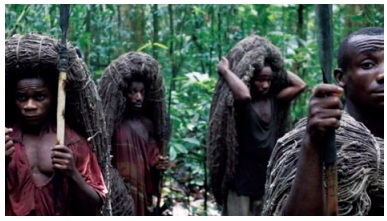
Pigmies
The pigmies are Negroid people and are
also called Negrillos. They are short stature, flat nosed, wooly haired, long headed
and black people. The average height of men and women are found 150cm. So they are
also called dwarf. The pigmies are those who live in scattered parts of tropical
Central Africa. They are found in many sub-groups in the equatorial forest region
of Africa mainly in Congo basin 3ºN and 3ºS latitudes along both sides of the equator.
In addition some groups of Pigmies are also found in the forests of Philippines
and New Guinea.
Masai
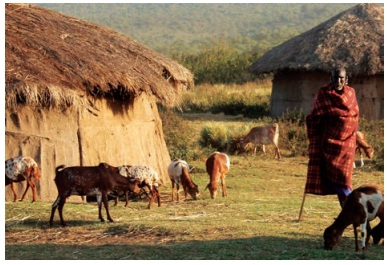
The Masai of east Africa belong to the
pastoral society and are known as the best and most typical cattle herders not only
of Africa but also of the world. Masai people are tall and slender with ling feet,
hands and fingers. Their skin colour ranges from light chocolate to dark brown.
They have high and long head, thin face and nose. Their lips are less thick than
that of Negroid people. Masai occupy the interior plateau of the equatorial Africa.
The territory of the Masai lies between 1ºN and 6ºS latitudes and covers all the
rift valleys in this region.
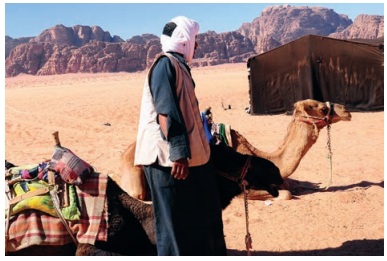
Bedouin
In Arabic, Bedouin means desert dwellers.
The Bedouins are most important among the tribal of South West-Asia and North Africa.
They are pastoral nomads and keep camel, sheep, goats, horse etc. The Bedouins occupy
the desert areas of the Arabian Peninsula including Saudi Arabia, Yemen, Oman, Syria
and Jordan. The Bedouins belongs to the mixture of Mediterranean and Armenian races.
They are medium stature people with long narrow face, prominent nose, dark eyes
and hair. Their complexion is wheatish to pale.
Bushman
Bushman is the tribal people of Kalahari
Desert in southern Africa who are still engaged in hunting and gathering economics.
They are on constant run for both food and water. Their homeland Kalahari Desert
lies in Botswana, Namibia and southern Angola. The bushman territory is a wide plateau
about 2000 meters above the sea level with sub tropical climate. The bushman are
included in the Negroid stock. They are very short in stature and have long head,
short and flat ears, and yellowish brown complexion. On the whole the Negroid characteristics
prevail among the Bushman.
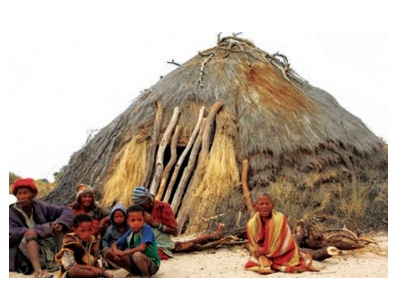
Eskimos
Eskimos also called Inuits are tribes
of tundra cold region in Canadian northland, Alaska, Greenland and north-eastern
Siberian coastal region. The Eskimos are Mongoloid race. The main physical characteristics
of the Eskimos are short stature, Flat narrow face, small snub nose, yellow –brown
complexion and coarse straight black hair. Hunting and fishing are the main occupations
of the Eskimos. They live in igloo and practice hunting way known as Maupak. The
Eskimos wear clothes of caribous or reindeers skin and other furs.
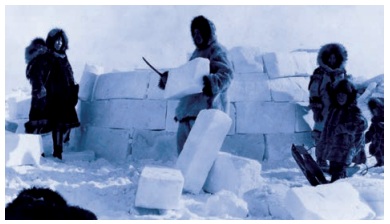
Eskimos are migratory by nature and construct
ice houses called Igloos. For travelling on ice shield the Eskimos use sledge which
is usually built either of whale bone or of wood whichever is available. It is drawn
by two or more dogs, caribous or rain deer.

Tribal in India
India is the home to large number of
indigenous people, who are still untouched by the lifestyle of the modern world.
With more than 84.4 million, India has the largest population of the tribal people
in the world. These tribal people also known as the adivasis are the poorest in
the country, which are still dependent on haunting, agriculture and fishing. Some
of the major tribal groups in India include Gonds, Santhals, Khasis, Angamis, Bhils,
Bhutias and Great Andamanese. All these tribal people have their own culture, tradition,
language and lifestyle. There are more than 50 tribal groups in India. Most of the
tribal belong basically to the Negroid , Australoid and Mongoloid racial stocks.
Bhils
Bhils are popularly known as the bow
men of Rajasthan. They are the most widely distributed tribal groups in India. They
form the largest tribe of the whole South Asia. Bhils are mainly divided into two
main groups the central or pure bills and eastern or Rajput Bhils.
Gonds
The Gonds are the tribal community mostly
found in the Gond forests of the central India. They are one of the largest tribal
groups in the world. Gonds have been largely influenced by the Hindus and for the
long time have been practicing the Hindus culture and traditions.
Santhals
Santhals are the third largest tribe
in India. They are mostly found in the states of West Bengal, Bihar, Odisha, Jharkhand
and Assam. They belong to the pre- Aryan period and have been the great fighters
from the time of the British.
Munda
Munda tribe mainly inhabit in the region
of Jharkhand, although they are well spread in the states of West Bengal, Chhattisgarh,
Odisha and Bihar. Munda generally means headman of the village. Hunting is the main
occupation of the Mundas tribe.
Khasi
Khasi tribe is mainly found in the Khasi
Jaintia hills in Meghalaya and in the states of Punjab, Uttar Pradesh, Manipur,
West Bengal and Jammu and Kashmir. They form the large part of the population in
the state of Meghalaya.
Angami
Angami tribe belongs to the extreme north
eastern part of the country, in the state of Nagaland. The total population of the
Angamis is around 12 million. They are quite popular for their woodcraft and artwork.
Sekrenyi is the main festival celebrated among the Angamis in Nagaland
Bhutia
Bhutia tribes are of the Tibetan origin.
They migrated to Sikkim around 16th century. In the northern part of the Sikkim
they are known as the Lachenpass and Lachungpass.
Bhutias forms 14% of the total population
of Sikkim. Losar and Losoong are the main festivals celebrated among the Bhutia
tribes.
Chenchu
Chenchu inhabit in the Nallamalai
hills, which have been the part of the Nagarjuna Sagar Tiger Sanctuary for
centuries in Andhra Pradesh, India. They are mainly found in the districts of
Mahabubnagar, Nalgonda, Praksham, Guntur, and Kurnool.
Great
Andamanese
Great Andamanese is the Negroid
tribe inhabitant in the Andaman group of Islands. They form the largest
population among the other tribes found in these islands. According to the
census the population of Great Andamanese is now limited to few individuals.
CASE STUDY
The Sentinelese tribe, the most dangerous tribe in the world!
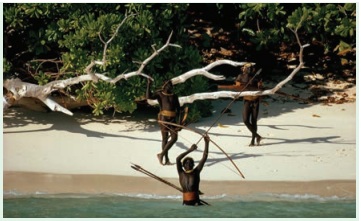
Located far into Andaman
and Nicobar Islands, the Bay of Bengal in the Indian Ocean, North Sentinel Island
is one of the most isolated places on earth. This remote island is home to the Sentinelese
tribe, the most dangerous tribe in the world. The Sentinelese are hunter-gatherers,
as agriculture is not known to them. Their diet consists mainly of coconuts and
fish that can be found in the shallow waters around their shores. The Sentinelese
would be described as Stone Age people. The women wear fibre strings tied around
their waists, necks and heads. The men also wear necklaces and headbands, but with
a thicker waist belt. The men carry spears, bows and arrows. Sometimes the Sentinelese
appeared to make friendly gestures at others they would take the gifts into the
forest and then fire arrows at the contact party. The population of North Sentinel
Island is estimated at 250 individuals. The Sentinelese do not want help from outsiders.
Tribals in Tamilnadu
Tribes of Tamil Nadu are concentrated
mainly in the district of Nilgiris. Of all the distinct tribes, the Kodas, the Thodas,
the Irulas, the Kurumbas and the Badagas form the larger groups, who mainly had
a pastoral existence. Other tribes include, Kattunayakan and Paliyan.
According to census 2011, tribal population in Tamil Nadu is 7, 94,697. There are around 38 tribes and sub-tribes group in Tamil Nadu. The tribal people are predominantly farmers and they are much dependant on the forest lands.
Toda:
Men from the family of the tribes are occupied in milking and grazing their
large herds of buffaloes. Their settlements are known as ‘Munds’. They do not worship
any god and their consciousness is cosmic. They live in Nilgiris. Today, there are
about a thousand Todas left.
Badaga:
The Badagas belong to the backward class and are not classified as
tribal. They are an agricultural community, dwelling in the higher plateau of the
Nilgiris district in the state of Tamil Nadu. They are engaged in tea cultivation
and potato growing. They form the largest group of tribes and boast a rich oral
tradition of Folk tales, songs and poetry. These tribes are Hindu and belong to
the shiva sect.
Kota:
The Kotas are mainly concentrated in the Tiruchigadi area in the Nilagiri
hills. They are distinguished by their colourful Folk dances and are basically musicians,
who play at Badaa funerals. They are mainly engaged in producing handicrafts. These
tribes of Tamil Nadu are expert iron smiths, potters and carpenters. In order to
maintain distance and status in society, the Kotas implement elaborate tattoos.
Kurumbas: The Kurumbas tribes of this state inhabit the intermediate valleys and forests in Villages and were known for their black magic and witchcraft in the past. Their way of living today has changed from their original gathering and hunting existence to working in Coffee and Tea plantations as labourers. Kurumbas are perhaps the only main caste in southern India that has a specialized and distinctive Kurumbas Language.
Irula:
The Irula tribes of Tamil Nadu occupy the lower slopes and forests at
the base of the Nilgiri Hills. They constitute the second largest group of tribes
after the Badagas and are similar to the Kurumbas in many ways. This tribe produces
honey, fruits, herbs, roots, gum, dyes etc., and trades them with the people in
the plains. In the recent times the Irulas help in catching snakes and collect the
snake venom.
Paliyan:
They are of the food gathering communities of Tamil Nadu. It is believed
that the Paliyan originally belonged to the Palani hills. They are distributed in
the districts of Madurai, Tanjavour, Pudukkottai, Tirunelveli and Coimbatore.
Language
Language is an identification mark for different cultures. Because language is essential to communication, it strongly influences the sort of political, social and economic we create. As a result, economic and religious system frequently follows patterns of language distribution and political borders quite often parallel linguistic boundaries. In modern times linguistic diffusion has been facilitated by trade, tourism, media and international organizations. It has helped in the development of the linguistic pluralism. The greatest linguistic diversity is attributed to heterogeneous societies.
Tamil is one of the longest-
surviving classical languages in the world. The earliest period of Tamil literature,
Sangam literature, is dated from 300 BC (BCE) – AD (CE) 300. It has the oldest extant
literature among Dravidian languages.
Major linguistic Families of the World
The classification of languages by origin
and historical development is known as a genetic classification. The languages which
are the descendants of common ancestral language are called proto – language
G.L. Trage has classified the languages
of the world into 7 linguistic phylum and 30 linguistic families. Linguistic families
are further classified in to sub families of languages, which denote major languages.
1. Indo-European
- a. Indo-Iranian, b. Latin or Romantic, c. Germanic, d. Balto –Slavic, e. Celtic,
f. Hellenic
2. Sino-Tibetan
- a. Chinese, b. Tibetan, c. Burman
3. Afro-Asiatic
– a. Semitic, b. Egyptian, c. Cushitic, d. Chadic
4. African
– a. Niger – Congo (Atlantic, Voltaic, Benu-Nagar)
b. Sudanic
(Chari-Nile, Saharan,) c. Click Languages (Khoisan)
5. Ural-Altaic
- a. Finno-Igric, b. Turkic, c. Mangolic, d. Tunguzic
6. Dravidian- malayo – Polynesian-a. Dravidian,
b. Malayan, c. Melanesian,
d. Micronesian, e. Polynesian, f. Austro-Asiatic.
7. Palaeo Asiatic- a.Yukaghir
As many as half of the world’s 7,000 languages are expected to be extinct
by the end of this century; it is estimated that one language dies out every 14
days.
Major Languages of India
India has a rich Linguistic heritage
and has heterogeneous ethnic and social groups, which have their own languages and
dialects. According to census of India 1961, there were 187 languages spoken by
various sections of Indian society. 23 major languages were spoken by about 97 percent
population of the country. 22 languages excluding English are mentioned in the eighth
schedule of the constitution of India as follows; Kashmiri, Punjabi, Hindi, Urdu,
Bengali, Assamese, Guajarati, Marathi, Kannada, Tamil, Telugu, Malayalam, Sindhi,
Sanskrit, Oriya, Nepali, Kongani, Manipuri, Bodo, Dogri, Maithili and Santali of
these languages, 14 were initially included in the Constitution. Subsequently, Sindhi
was added in 1967 by 21st constitutional amendment act; Konkani, Manipuri and Nepali
were added in 1992 by 71st Constitutional Amendment Act; and Bodo, Dogri, Maithili
and Santali were added in 2003 by 92nd Constitutional Amendment Act. Indian Languages
belong mainly to four linguistic families
1. Austric
– Munda, Mon-Khmer
2. Dravidan
– Tamil, Telugu, Kannada, Malayalam, Gondi, kurukh, orean, etc.
3. Sino-
Tibetan- Bodo, Karen, Manipuri, etc.
4. Indo - Aryan – Hindi, Urdu, Sans.
Dialect
A distinct linguistic form peculiar to
a region or social group but which nevertheless, can be understood by speakers of
other forms of the same language. The two main types of dialects are the geographic dialect, spoken by the people
of the same area or locality, and the social
dialect used by people of the same social class, educational level or occupational group.
Major dialects in India
More than 40 languages or dialects in
India are considered to be endangered and are believed to be heading towards extinction
as only a few thousand people speak them officials said.
According to a report of the census Directorate,
there are 22 scheduled languages and 100 non –scheduled languages in India. The
scheduled languages are 11 from Andaman and Nicobar, Seven from Manipur and Four
from Himachal Pradesh. There are 42 languages spoken by less than 10,000 people.
Some other languages also are in endangered position in India.
Major
dialects in Tamil Nadu
Tamil is an interesting language with
a range of native dialects. The language has several charming improvisations in
different regions of the state. Many people are familiar with the old and familiar
dialects of Tamil such as Chennai, Coimbatore, Madurai and Tirunelveli.
Fact File
UNESCO’S five levels of
language risk:
Safe: Widely spoken
Vulnerable: Not spoken by children outside
the home (600 languages)
Definitely endangered: Children not speaking
(646 languages)
Severely endangered: Only spoken by oldest
generations (527 languages)
Critically endangered: Spoken by only a few members
of the oldest generation, often semi-speakers (577 languages)
Related Topics